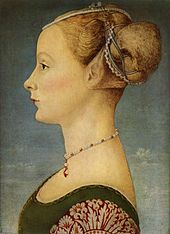 Sandro Botticelli, Primavera (c. 1478) | |
| Years active | Early 15th to late 16th century |
|---|---|
| Location | Republic of Florence |
| Major figures | Painting: Masaccio, Leonardo da Vinci, Michelangelo, Raphael.Architecture: Lorenzo Ghiberti, Leon Battista Alberti, FilareteSculpture: Andrea del Verrocchio, Filippo Brunelleschi, Donatello, Michelangelo, |



The Florentine Renaissance in art is the new approach to art and culture in Florence during the period from approximately the beginning of the 15th century to the end of the 16th. This new figurative language was linked to a new way of thinking about humankind and the world around it, based on the local culture and humanism already highlighted in the 14th century by Petrarch and Coluccio Salutati, among others. Filippo Brunelleschi, Donatello and Masaccio's innovations in the figurative arts at the very beginning of the 15th century were not immediately accepted by the community, and for some twenty years remained misunderstood and in the minority compared to International Gothic.
Thereafter, the figurative language of the Renaissance gradually became the most popular and was transmitted to other Italian courts, including the papal court, as well as to European courts, thanks to the movement of artists from one court to another. Contact with these travellers gave rise to local disciples.
The Florentine Renaissance was divided into several periods. Until the middle of the 15th century, this movement was based on technical and practical approaches, then a second phase covering the period of Lorenzo de' Medici's reign, from 1450 to 1492, was characterised by mainly intellectual contributions. The third phase was shaped by the precepts of Girolamo Savonarola, who had a profound and lasting influence on many artists, calling into question freedom of choice through the establishment of a theocratic state in Florence. From 1490 to 1520, the High Renaissance corresponds to the period of "experimentation" by the three major figures of the Renaissance: Leonardo da Vinci, Michelangelo and Raphael. The art of the period which followed is known as Mannerism.